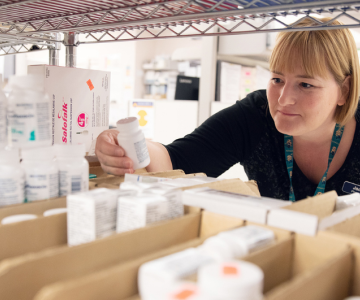Breadcrumb
Explore Stories
3 Minute Read
Research & Innovation
Our family was recently impacted by an emergency, and an aging relative was hospitalized. With ongoing restrictions due to COVID, there were limitations to in-person visits and some family members involved in care live afar. After the acute event was over and our aging loved one was back home, I reflected on how much of our communication and caregiving was done virtually – texting, email, videoconference, apps to feel closer to each other, online booking for transportation and apps designed to help coordinate tasks and scheduling.
Using technology-based interventions and other digital applications is increasingly becoming a viable option to support family caregivers both in their role as a caregiver and for their own well-being.
3 Minute Read
Community & Culture
Jennifer Thur (left), an Obstetrics Registered Nurse at Royal Inland Hospital, and Jessica Rathgeber, Obstetrics Nursing Student
We’re privileged at Interior Health to support more than 6,000 students who walk through our doors, breathing fresh excitement into our hallways. Preceptorship, the advising relationship between an experienced professional and a student entering the field, serves as an absolute cornerstone of education in health care.
IH’s dedicated employees spend more than 500,000 hours serving as preceptors across the organization each year.
2 Minute Read
Research & Innovation
If necessity is the mother of invention, then it only makes sense that the need for continued interaction with each other during the pandemic lockdown meant people changed the way they communicated. By adopting more innovative avenues like videoconferencing, they found they could successfully achieve many tasks – including the ability to have a quality virtual health-care appointment with their care provider.
Even for people who don’t consider themselves to be savvy with computers, improved technology and support makes virtual visits easier. In fact, many people find virtual visits are more convenient to fit into their busy schedules than an in-person visit.
2 Minute Read
Community & Culture
Name: Ryan Benson (she/her/hers)Job Title: Improvement ConsultantYears of Service: 14Worksite: Community Health & Services CentreCommunity: KelownaAncestral Territory: SyilxAdvice to live by: “Life is short – use the good china.” - Unknown
As an Improvement Consultant with Interior Health, Ryan Benson likes to bring positivity and a sense of a can-do attitude to everything she encounters in her day.
5 Minute Read
Health & Wellness
Medications are prescribed to treat symptoms and to manage medical conditions or mitigate the risk of future events. It’s important to take the right medication at the right time and in the right dose. When we don’t take medications properly, it can lead to ineffectiveness, side effects and possibly even harm.
There are many reasons why someone may not take their medications properly. Patients may stop taking their medications because they’re confused by the directions, they feel the medications aren’t working, or because of the side effects. Cost can be another barrier to taking medications properly. Some patients may skip doses or reduce frequency to extend the medication so that it lasts longer.
Pharmacists are a great option for helping people manage their medication.
2 Minute Read
Health & Wellness
Housing is both a basic need and a human right. And yet, many people in the Interior Health region are without homes.
The reasons behind why someone may become homeless are complex, interconnected and are no fault of the individual. In fact, homelessness can happen to anyone – and the stigma associated with not having a home can create barriers to healthy living opportunities for those who are experiencing homelessness.
“Having a home is a basis for everything. Without it, it’s impossible to do anything … all you can do is survive,” says Shane, a resident at a Vernon supportive housing facility featured in a recent BC Housing video. “The general public considers us dirty and bad. And like, everybody’s a criminal, and that’s not the case.”
People without homes are constantly experiencing stigma, prejudice and discrimination. Terms such as “bum” and even labels such as “homeless person” dehumanize the person behind the situation and takes away from individual identity. Negative stereotypes and stigma increase the shame and embarrassment of people living without homes; this, in turn, creates barriers to seeking help and further perpetuates poor health outcomes. Using non-stigmatizing language can help.
Individuals living without housing are often in survival mode, trying to meet very real life-or-death needs like securing food to eat, finding a safe place to sleep and trying to stay out of the elements. People experiencing homelessness often have poorer physical and mental health outcomes, including high rates of infectious and chronic disease, severe mental illness, and premature death.
Having access to good quality, accessible, appropriate and affordable housing can support the health and well-being of individuals and communities. For example, access to affordable housing can reduce stress and allow people to take better care of themselves and their families by having more disposable income. More disposable income then allows people to spend money on healthy food, medication, recreational opportunities, and educational opportunities which, in turn, can help reduce health inequities.
As resident Jill says in the BC Housing video: “I don’t know that I’d ever be able to be who I am, and who I want to be … if I wouldn’t have had a place to live.”
Healthy housing contributes to a sense of safety, greater social well-being and improved quality of life.
Learn more:
Health & Housing Infographic _Page 1 (interiorhealth.ca)
Substance Use & Addiction Services | Health & Wellness | IH (interiorhealth.ca)
BC Housing video – My Place Supportive Housing in Vernon BC
BC Housing Podcast
2 Minute Read
Community & Culture
Name: Janet Quesnel (she/her/hers)Job Title: Registered Nurse Years of Service: 35Worksite: Ashcroft Hospital & Health CentreCommunity: AshcroftAncestral Territory: Nlaka’pamuxAdvice to live by: Treat others as you expect to be treated, and respect others as you expect them to respect you.
Hailing from Edinburgh, Scotland, Janet Quesnel immigrated in 1966 to Wabush, Labrador. She made her B.C. debut with a move to Logan Lake in 1972 and has been in Ashcroft since 1987. A registered nurse (RN), Janet has been with Interior Health for 35 years.
4 Minute Read
Research & Innovation
Nurse Simomo Ndebele says both patients & health-care professionals will benefit from the new Phil & Jennie Gaglardi Tower at Royal Inland Hospital in Kamloops.
A new era for the Royal Inland Hospital (RIH) in Kamloops will begin in July when a vision that has been in the works for years comes to reality with a massive capital investment in the region: the opening of the Phil & Jennie Gaglardi Tower at RIH. The new nine-storey hospital will continue to modernize the RIH campus, building on the opening of the Clinical Services Building in 2016.
During the design and construction of the Gaglardi Tower, health-care professionals were able to provide input into the design to ensure staff and physician working conditions were considered and to put patient care at the forefront. RIH registered psychiatric nurse Simomo Ndebele, known as Mo around the hospital, was one of the people who made the Gaglardi Tower a made-in-Kamloops-for-Kamloops design.
2 Minute Read
Health & Wellness
When my frail elderly aunt had a fall at home, she was admitted to Penticton Regional Hospital emergency department for assessment. The care team listened to our concerns and worked with us to figure out how best to assess her, because we knew her best and understood what her usual behaviours and abilities were.
Later in the day, the physician contacted us to explain the assessment, interventions and follow up and then asked my husband, “how do you feel about taking her home?”
I was really impressed with the question and relieved to know we weren't just going to be told she was being discharged.
While my aunt was in their care that day, the care team had built a relationship of trust and we were happy to bring her home knowing the team had assessed her carefully and planned for what interventions would be necessary for her to go home.
Recent research shows there is a strong connection between how well you plan for someone to be sent home (discharged) from the hospital, and the likelihood that they will need to go back to the hospital (readmitted). This is especially true for older people.
Team-based care (like the kind my aunt received) stresses the importance of including family as valued members of the health-care team, particularly when planning for a person to leave the hospital. Team-based care also focuses on communicating openly with patients and families to balance the caregiver’s needs and expectations with the discharge process offered by the facility.
Want to learn more? Check out our information on Getting discharged from hospital.
About the author:
Mary Kjorven is a gerontologist and works with Interior Health as a regional clinical nurse specialist
-
Load More
Showing 369 of 677
STAY CONNECTED
Receive news and alert posts, and Stories@IH blog posts, right to your inbox!









